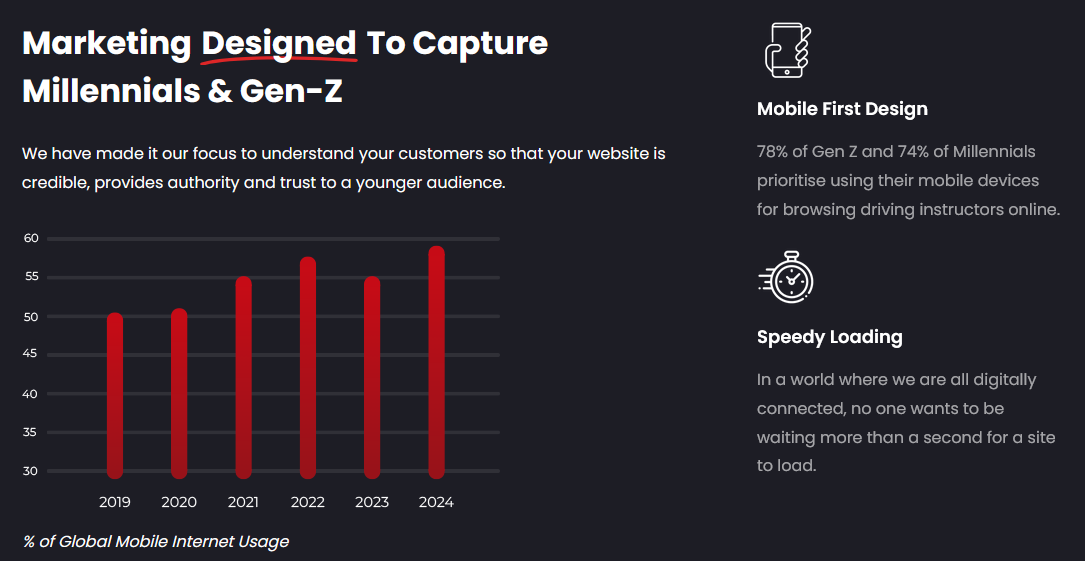As a driving instructor, your primary goal is to attract new students and help them become confident, skilled drivers. In today’s digital age, having an effective online presence is crucial to achieving this goal. A well-designed website can significantly enhance your marketing efforts, driving more traffic and converting visitors into loyal clients. Here are seven top marketing tips to make your driving instructor website a powerful tool for your business.
1. Create a User-Friendly Design
First impressions matter. Your website should be visually appealing and easy to navigate. Use a clean layout, professional images, and clear calls-to-action (CTAs) to guide visitors. Ensure that your site is mobile-friendly, as your target audience (18-24) will more than likely access it from their smartphones.
Test your website’s responsiveness on mobile to ensure a good user experience.

2. Optimize for Search Engines (SEO)
Search Engine Optimization (SEO) is crucial for making your website visible to potential clients. Use relevant keywords such as “driving lessons,” “learn to drive,” and “driving instructor near me” throughout your site. Focus on creating high-quality, informative content that answers common questions and concerns.
Utilize tools like Google Keyword Planner to identify popular search terms in your industry.
Use Whatsmyserp to check how high your website appears for local searches in Google.
3. Leverage Social Proof
People are more likely to trust and choose a driving instructor with positive reviews and testimonials. Display client testimonials prominently on your website. Consider adding a dedicated page for reviews or integrating a live feed of positive feedback from platforms like Google My Business or Facebook.
Encourage satisfied students to leave reviews and share their experiences on your social media pages.
4. Offer Valuable Content
Position yourself as an expert by providing valuable content that helps potential students. Write blog posts, create show me tell me questions, and offer downloadable guides on topics like what to expect on the test day, tips for nervous drivers, and choosing the right driving instructor. This not only builds trust but also improves your SEO.
A great example would be that on our own website, we share key information about Millennials & Gen-Z online demands to help our users understand theirs.

5. Implement Clear Calls-to-Action
Your website should guide visitors towards taking specific actions, such as booking a lesson, requesting more information, or signing up for a newsletter. Use clear, compelling CTAs throughout your site. Make it easy for potential clients to contact you by providing multiple contact options, including phone, email, and a contact form.
Place CTAs in prominent locations, such as at the end of blog posts, on the homepage, and within the site header.
Get a new, Free, Premium
Driving Instructor Website
Only £29.99
/month hosting
6. Track and Analyze Your Performance
Use tools like Google Analytics to monitor your website’s performance. Track metrics such as page views, bounce rates, and conversion rates. Understanding how visitors interact with your site can help you make informed decisions about what to improve.
7. Target Local Advertising
As a driving instructor, your target audience is local. Optimize your website for local searches by including your city or region in your keywords, meta descriptions, and content. Create a Google My Business profile and ensure your business information is accurate and up-to-date.
Final Thoughts
By implementing these seven marketing tips, you can create a compelling and effective online presence that attracts more students. Remember, your website is often the first point of contact with potential clients, so make sure it represents your brand professionally.
To summarise:
- Create a User-Friendly Design
- Optimize for Search Engines (SEO)
- Leverage Social Proof
- Offer Valuable Content
- Implement Clear Calls-to-Action
- Track and Analyze Your Performance
- Target Local Advertising



